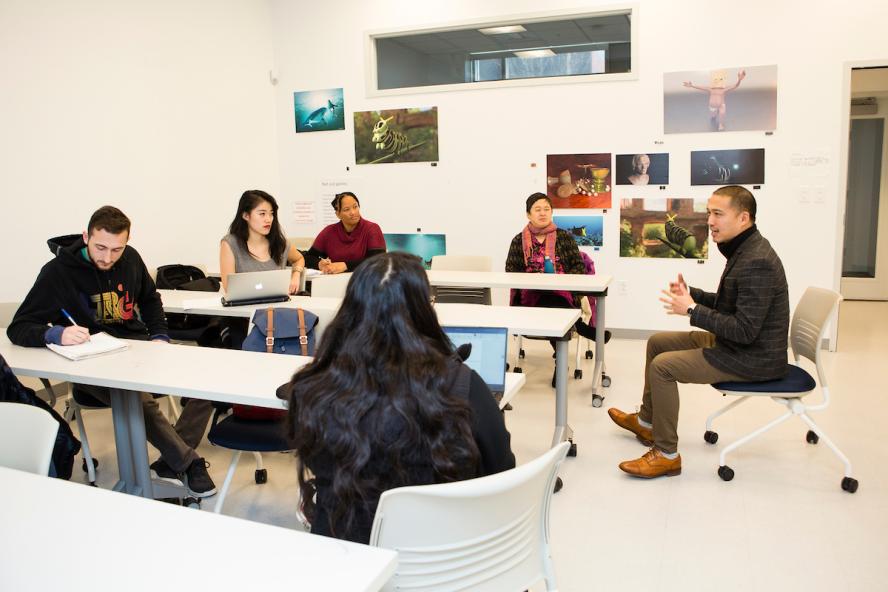-
About
-
Academics
- Physician Assistant
- Special Master’s (MBS)
-
Admissions & Financial Aid
- Tuition & Fees
-
Student Life
-
Research
- Research Labs & Centers
-
Local & Global Engagement
- Global Health Program
Sense of Place
Tufts University School of Medicine Department of Public Health and Community Medicine’s new field course “Introduction to Building Healthy Neighborhoods and Communities” immerses students in Boston’s vibrant Chinatown neighborhood.

By Courtney Hollands
During one of the first sessions of “Introduction to Building Healthy Neighborhoods and Communities”—a new field course offered last fall by the School of Medicine’s Department of Public Health and Community Medicine—five students took a walking tour of Boston’s Chinatown. As they assembled under the neighborhood’s iconic, lion-flanked gate, noises from nearby construction all but drowned out the guide’s voice.
Later, in their reflections on the experience, several students wrote about the din. “Being in that environment, hearing that kind of noise, and seeing the hustle and bustle gave them a better sense of what it’s like to live and work in that community,” said professor Carolyn Rubin, who also directs the Addressing Disparities in Asian Populations Through Translational Research (ADAPT), a Tufts Clinical and Translational Science Institute project.
And that’s exactly the point: It’s one thing to read studies and textbooks about public health; it’s quite another to immerse yourself in a community’s rich culture and day-to-day life. The interactive course—which Rubin will teach again next year—encompasses off-site visits, in-class lectures, and discussions with community partners in Chinatown, a vibrant immigrant enclave that has been squeezed in recent years by high rents and gentrification. Health concerns in the neighborhood include chronic stress, mental health issues, smoking and its consequences, and diabetes and other chronic diseases—as well as obstacles to health-care access.
For Jasmin Shores, a first-year student in the Master of Public Health program who starts medical school next year at Tufts, talking with two residents about living costs, the language barrier, sending their children to distant schools, and more was especially illuminating. “I saw that a lot of their health issues and challenges were related to this huge amount of stress that’s affecting their quality of life,” Shores said. “Just hearing from them was really insightful.”
Second-year Doctor of Public Health student Helga Zaire agreed. “It’s very helpful . . . when you talk to people who are facing problems, to hear their views and the way they analyze the situation,” she said.
The off-site visits, meanwhile, give students an up-close look at the work various health and housing groups are doing in the community, Rubin said. When the class toured the Greater Boston Golden Age Center, they learned how the nonprofit serves the elderly through adult day programs and checked out the lunchroom and one of the apartments. “I hope that students understand that if they’re trying to improve health at the neighborhood or community level, there are multiple stakeholders who need to be involved in that conversation,” Rubin said. “They learn that this kind of work is messy and complex—and it requires dialogue.”
To wit: The final group project focused on how land use affects the overall health and well-being of a neighborhood through the lens of R-1, one of Chinatown’s last remaining parcels of public space. Though Tufts has leased the lot from the city for parking, students interviewed various stakeholders and reviewed documents to recommend ways the university, Tufts Medical Center, and Chinatown can work together to ensure the space benefits all.
Another stop on the Chinatown walking tour last fall was a colorful new mural designed by the Asian Community Development Corporation’s youth group. Titled “Tied Together by a Thousand Threads,” it shows eight connected bubbles filled with residents’ memories of struggle and strife, yes, but also dim sum, the historic elevated Orange Line train, and grocery stores. “My class is not just talking about the problems in Chinatown—it’s really about what the community is actively doing to address the health inequities in the neighborhood,” Rubin said. “I want students to see communities as active and resilient, and not just acted upon.”
This article originally ran in the Winter 2018 issue of Tufts Medicine.